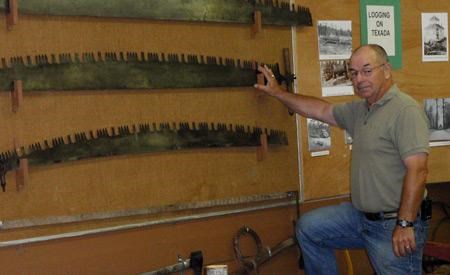by Sandy McCormick Peak Contributor When Ken Barton, 64, went to a Texada Island Heritage Society meeting in 1997, history was in the making. Since then, the group opened two museums, forged community partnerships, began archiving the society’s extensive inventory of artifacts and integrated school programs into the museums with field trips to historical sites for classes from Texada and Powell River.
In Ken’s spare time, he is a four-term director with First Credit Union, an 11-year member of Gillies Bay Volunteer Fire Department, Texada’s representative on the Northern Sunshine Coast Ferry Advisory Committee, past-president of the island’s Health Society and Chamber of Commerce, and currently Texada’s only bagpiper. He’s also a teacher, miner, boat-builder and sailor.
Born in Victoria, Barton and his family moved to Osoyoos when he was a child. His father, Tom Barton, a BC gymnastics champion in the 1930s and a World War II Hong Kong veteran, became the local immigration officer and bought a house on Osoyoos Lake, financed with a handshake with the CEO of the town’s credit union. “Because of that, I’ve been a credit union member ever since,” said Ken. “It was a great grounding in cooperative philosophy.”
After high school in Oliver, he earned a degree in physical education and recreation administration from the University of Alberta in Edmonton, where he also met his wife Ruth, from Vancouver. “We both wanted to move back to BC and decided whoever got a job first back here, we’d take it.” Ruth got the first job, as a health records administrator at Nelson Hospital.
With Ruth employed in Nelson, Ken was soon teaching at Notre Dame University and running the school’s intramural program. “We put together a hockey team, including one player nicknamed ‘wild’ Bill Fielkowich from the tiny community of Blubber Bay. I had no idea where that was.”
In 1971, the Bartons moved north to Stewart, where Ken was the town’s recreation director. Seeking a bigger paycheque, he took a job at Granduc Mine nearby where he built roads underground. However, the following year a mine tunnel collapsed and Ken was injured. The Bartons moved to Vancouver so he could recouperate. While recovering, he earned a BC Teachers’ Certificate from University of British Columbia and then taught for 27 years in Surrey.
For recreation, he built a 34-foot fibreglass sailing sloop which they sailed along the BC coast, and which he also used for teaching students in an alternate education program. While returning from Desolation Sound in 1997 with students aboard, Ken met a Powell River school district official who encouraged him to apply to teach at Brooks Secondary School. He was hired by the district for that fall, but due to a drop in student population the only job available was half-time on Texada, whose school then had 158 students in kindergarten through grade 10. Ken took the job.
The Bartons and their two children lived on their sailboat in Marble Bay before buying a house in Gillies Bay. “We wanted a change from the big city and loved the lifestyle on Texada,” he said. So when the job became full-time the following year, they decided to stay. He taught at the school in Van Anda until 2004.
Ken got to know many of the “old-timers” and found their stories interesting. He joined the Heritage Society in 1998 and has been president since 2001. The society sought out a cooperative relationship with Ash Grove Cement, which owns the limestone quarry at Blubber Bay. As a result, the company donated a small building, nicknamed the “Thacker house” for the last family who lived there, to the society for Texada’s first museum. It sits on quarry land, just above the ferry terminal behind Holtenwood Gallery, and opened in 2001.
The society began archiving its hundreds of artifacts onto CDs. With student population falling, the school district leased an empty classroom to the society and it opened as a second museum in 2008. The curator is Doug Paton with assistance from Clarence Wood, who was formerly curator of Barkerville Museum. The museum at Van Anda school has since expanded to occupy a four-classroom wing, with displays of logging, mining and the way Texada City and Van Anda used to be.
In 2010, the society formally became a Heritage Commission, qualifying it for higher grant funding for summer programs and other work. The group is currently seeking to preserve historic limekilns at Marble and Limekiln bays. “Texada’s history very much mirrors that of many small mining and logging towns which came to prominence in the last 150 years. Our history is about who we are, where we come from and where we are going in the future,” Ken said.
He learned to play the bagpipes from pipe majors of the Powell River Clansmen who he met in 2004 at a dinner at the Royal Canadian Legion Texada branch. He played with the group for two years before increased ferry fares made it prohibitive. However, Barton says he is more optimistic about BC Ferries since meetings in September with the provincial ferries commissioner.



